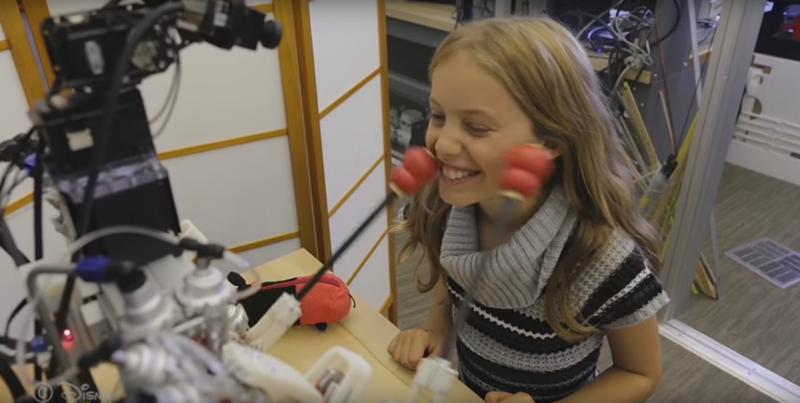Almost every big corporation has a research and development organization, so it came as no surprise when we found a tip about Disney Research in the Hackaday Tip Line. And that the project in question turned out to involve human-safe haptic telepresence robots makes perfect sense, especially when your business is keeping the Happiest Place on Earth running smoothly.
That Disney wants to make sure their Animatronics are safe is good news, but the Disney project is about more than keeping guests healthy. The video after the break and the accompanying paper (PDF link) describe a telepresence robot with a unique hydrostatic transmission coupling it to the operator. The actuators are based on a rolling-diaphragm design that limits hydraulic pressure. In a human-safe system that’s exactly what you want.
The system is a hybrid hydraulic-pneumatic design; two actuators, one powered by water pressure and the other with air, oppose each other in each joint. The air-charged actuators behave like a mass-efficient spring that preloads the hydraulic actuator. This increases safety by allowing the system to be de-energized instantly by venting the air lines. What’s more, the whole system presents very low mechanical impedance, allowing haptic feedback to the operator through the system fluid. This provides enough sensitivity to handle an egg, thread a needle — or even bop a kid’s face with impunity.
There are some great ideas here for robotics hackers, and you’ve got to admire the engineering that went into these actuators. For more research from the House of Mouse, check out this slightly creepy touch-sensitive smart watch, or this air-cannon haptic feedback generator.
Thanks to [GARROW] for this tip.
















Interesting stuff, and impressive too, especially the haptic feedback sensitivity.
Now they just need to retrofit the alligators….
Worked out fine in Itchy and Scratchy Land.
Nothing could possably go wrong……Possibly go wrong. That’s the first thing that’s ever gone wrong….
It didn’t work out in “Westworld”, the robots went rogue. Obviously Disney is still worried about the negative, forty years later.
Michael
Yah I think they’re screwed. Det Del Spooner works for 21st Century Fox, John Connor for Universal and Rick Deckard for Warner Bros.
They were so close too, I, Robot was a Disney project with Bryan Singer attached waaaaay back yonder. He, of course, followed the project to 20thCF and ended up on X-Men…..
I’ve seen this somewhere before
http://hackaday.com/2014/10/10/ask-hackaday-who-is-going-to-build-this-pneumatic-transmission-thing/
This is a continuation and improvement, they now use an air/fluid combi system.
Plus they give the part number of the diaphragms which HaD was curious about.
” The fabric-reinforced nitrile rubber diaphragms used are IER Fujikura part number DM3-20-20, with a 24 mm stroke, for a 20 mm bore cylinder, withstanding a maximum operating pressure of 1.7 MPa (250 psi).”
I should probably add that I didn’t mean any disrespect to the article or author, Usually, the author adds the reference to the article when it’s previously been featured.
Not robots, Waldos, or if you want to use the not inspired by Robert A Heinlein term, remote manipulators.
So many good comments…
…robotic alligators next?